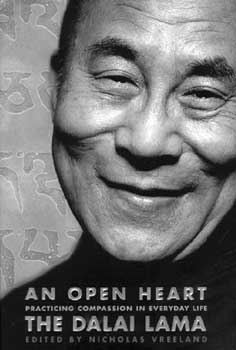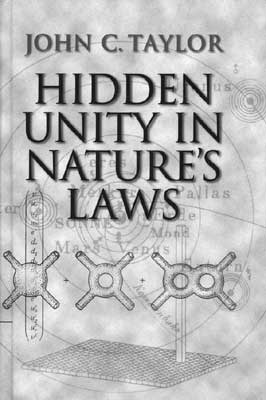
An Open Heart: Practicing Compassion in Everyday Life
by The Dalai Lama, edited by Nicholas Vreeland, Little, Brown and Company, Boston, 2001; 191 pages, ISBN 0316989797, hardback, $22.95.The Dalai Lama's best-selling Ethics for a New Millennium (1999) discussed in universal terms the need for living a moral life today, addressing particularly those in developed countries not practicing any religious tradition. His current book gives readers "a basic understanding of Buddhism and some of the key methods by which Buddhist practitioners have cultivated compassion and wisdom in their lives." He stresses, however, that "one doesn't have to be a Buddhist to make use of these meditation techniques. In fact, the techniques themselves do not lead to enlightenment or a compassionate and open heart. That is up to you, and the effort and motivation you bring to your spiritual practice" (pp. 29-30).
The introductory chapter, a 1999 lecture attended by 200,000 people in New York's Central Park, directly and simply expresses the personal and global importance of respecting everyone and transforming pride and anger into humility and love. In an accessible style lightened by humor, the Dalai Lama suggests in practical terms how we can become more compassionate. For example, he remarks that it is helpful to find something admirable in every person, and that we don't need to fall in with the negativity of others. Instead of mimicking the behavior of a hateful neighbor who is invariably rude, we can smile on him kindly, feeling pity for him. Soon the neighbor will stop out of frustration at not getting the angry reaction he is looking for. Impersonal love always defeats hatred, as Jesus suggested when saying we should turn the other cheek.

The remaining fifteen chapters were edited from a 1999 formal lecture series on Buddhist methods for achieving ultimate enlightenment through compassion and wisdom. It is based on two Tibetan Buddhist texts: Middle-Length Stages of Meditation by Kamalashila (8th century), which outlines the importance of analytical or mental practices to enlightenment; and The Thirty-Seven Practices of Bodhisattvas by Togmay Sangpo (14th century), which describes how to live a life dedicated to others.
The author's starting point is that everyone wishes to be happy and to avoid suffering. This could lead to a focus on oneself and one's exclusive benefit, but as the subtitle shows this is not his intent. Rather, he stresses that life is oneness, that all are inwardly kin, despite visual and other differences, and whatever affects one will in subtle ways affect all else. In each new life we confront the karma we have made -- ourselves -- and in so doing may refine and elevate our character so that we come to know intuitively how to live nobly. However, it is only by "an effort based on an understanding of how the mind and its various emotional and psychological states interact, that we bring about true spiritual progress" (pp. 60-1). The book outlines these states and the practices used at various stages along the bodhisattva path, ending with verses from 8th-century Indian Buddhist Shantideva:
With a wish to free all beings
I shall always go for refuge
To the Buddha, Dharma, and Sangha
Until I reach full enlightenment.
Enthused by wisdom and compassion,
Today in the Buddha's presence
I generate the Mind Wishing Full Awakening
For the benefit of all sentient beings.
As long as space remains,
As long as sentient beings remain,
Until then, may I too remain,
And dispel the miseries of the world.
This review only hints at the wisdom in this ecumenical book, and in these tense times its readers may feel more relaxed, realizing that right thought and right action, coupled with compassion, are inherent in human nature and, when practiced, in time will result in lasting strength and peace. -- Jean B. Crabbendam
Hidden Unity in Nature's Laws
by John C. Taylor, Cambridge University Press, Cambridge, 2001; 490 pages, glossary, bibliography, index, ISBN 0521659388, paper, $24.95.Continuing research in physics has revealed fewer, rather than more, natural laws. The author, a mathematical physicist specializing in particles and their forces, shows this to be the case in this splendid survey of physics, mainly since the time of Galileo. In the Preface he explains that one theme of this "non-technical tour through the principles of physics" is "that progress has often consisted in uncovering 'hidden unities.' . . . Every time such a unification is achieved, the number of 'laws of nature' is reduced, so that nature looks not only more unified but also, in some sense, simpler. More and more apparently diverse phenomena are explained by fewer and fewer underlying principles" (p. xi). The book's second theme arises because "Quite often, different branches of physics have seemed to contradict each other when taken together. The contradiction is then resolved in a new, more consistent, wider theory, which includes the two branches" (ibid.), such as the conflict between electromagnetism and Newton's theories of motion and gravitation being resolved by Einstein's relativity theories.

Organized partially chronologically, the book covers topics ranging from motion, heat, electromagnetism, and light, to space, time, and quantum and particle physics, with two-thirds of the book concentrating on 20th-century issues. Along the way it describes in an intriguing way the contributions of some of the prominent scientists whose work still has contemporary value. Concepts are explained largely through words and diagrams rather than mathematical notation, which the author feels is appropriate since "mathematical symbols can never be the whole story. You can write down as many elegant equations as you like, but somewhere there has to be a framework for connecting these symbols to real things in the world. To provide this, I do not think there is any substitute for ordinary language" (p. xii). -- I. M. Oderberg
(From Sunrise magazine, December 2001/January 2002; copyright © 2001 Theosophical University Press)
As we enter the sacred time around Christmas, I wonder about the deeper meaning of our celebration of the Holy Night. Is a Christmas tree really nothing more than a decorative addition? We can perhaps see behind the outward glamour of the tree with its candles, balls, silver tinsel, and a shiny star at the top by looking at it again with an open heart and listening to what it can tell us. In ancient philosophies and religions, we find that the tree has often been used as a symbol for the universe, whose roots sprang forth from the divine heart of all things and whose trunk, branches, twigs, and leaves were the different worlds and spheres. The colorful glass balls then stand for the manifold planets and globes, connected with everything else throughout the cosmos by the symbolic tinsel and festoons.
In one way the candles or electric lights represent the divine spark that is in every living being, linking us all together on a higher level and making of us potential gods. The Scandinavian tradition explains that the fruit of the cosmic tree contains the seeds of future "trees," beings who by inner growth have reached the end of their development on any one level. These entities, human beings or gods perhaps, are each a small universe and are destined in the future to enter upon still higher evolutionary paths in new forms of existence, to become eventually beings like their cosmic parent.
But the candles also denote light itself, which brings forth and is all life in the universe. Light is both spirit and matter, so that everything is really a form of light. Finally, the star at the top of the tree may symbolize our own highest self or, from a universal standpoint, the divine essence of the cosmos towards which all of us as god-sparks are striving.
These various thoughts may give us clues as to the hidden meaning behind our celebrating Christmas with a tree. -- Regina Thackara